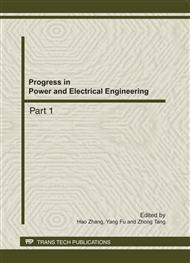p.137
p.145
p.149
p.153
p.159
p.165
p.170
p.174
p.179
Evaluating on Effect of HVAC Series with Impulse Excitation Voltage on Porcelain Insulator by Using Rotating Wheel Dip Test
Abstract:
This paper presents the effect of over-voltage damage on contamination surface of porcelain insulator due to impulse high voltage connects in series with high voltage alternating current (HVAC) which studied by using rotating wheel dip test. This method is artificially accelerated ageing at short period and mostly resemble real application of insulator. To evaluate this effect, the frequency of leakage current (LC) waveform has been analyzed by fast Fourier transform. The results of the experiment showed that effect of HVAC series with impulse excitation voltage created a LC like as transient state which it is highest amplitude peak values of LC flow on the specimen surface. The partial discharge on specimen surface suddenly occurs after excite by both excitation voltage at few number of cycles and increasing depends on number of cycles.
Info:
Periodical:
Pages:
159-164
Citation:
Online since:
October 2011
Price:
Сopyright:
© 2012 Trans Tech Publications Ltd. All Rights Reserved
Share:
Citation:


